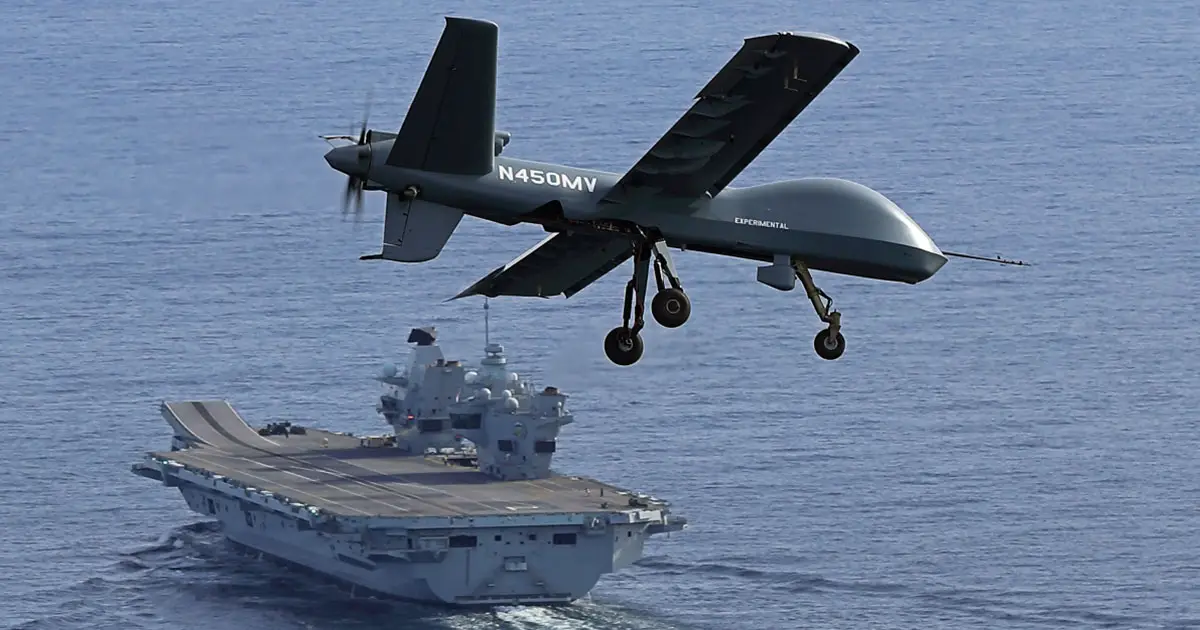General Atomics Aeronautical Systems, Inc. (GA-ASI) conducted a first-of-its-kind demonstration of its short takeoff and landing (STOL) capability on the HMS Prince of Wales, a Royal Navy aircraft carrier, using the Mojave Unmanned Aircraft System. The demonstration took place on November 15, 2023, when the Prince of Wales was underway off the East Coast of the U.S., and the Mojave was controlled by an aircrew within a control station onboard the ship. The demonstration included takeoff, circuits, and approaches and ended with a landing back onto the carrier. Mojave is a short takeoff and landing UAS demonstrator originally developed to prove STOL operations at unprepared landing sites. While Mojave shares common systems and components with GA-ASI’s Gray Eagle model, a STOL wing set option is likewise being planned for the larger, more capable MQ-9B aircraft, which includes SkyGuardian®, SeaGuardian®, and the new Protector RG Mk 1 currently being delivered to the UK Royal Air Force. The MQ-9B version, called MQ-9B STOL, is being considered by the Royal Navy and other navies that operate aircraft from large flat-deck warships without catapults and arresting gear.
Royal Navy Director Develop, Rear Admiral James Parkin, whose team planned the trial, said: “The Mojave trial is a European first – the first time that a Remotely Piloted Air System of this size has operated to and from an aircraft carrier outside of the United States. The success of this trial heralds a new dawn in how we conduct maritime aviation and is another exciting step in the evolution of the Royal Navy’s Carrier Strike Group into a mixed crewed and uncrewed fighting force.”
“We applaud the Royal Navy’s foresight in embracing this unprecedented capability for its carriers,” said GA-ASI CEO Linden Blue. “We knew our STOL capability would enable a UAS to safely take off and land on the Prince of Wales. Seeing our Mojave operate successfully in this environment opens myriad new ways our aircraft can be used to support multi-domain naval operations.”

The General Atomics Mojave is an unmanned aerial vehicle (UAV) capable of short takeoff and landing (STOL), being developed by General Atomics Aeronautical Systems. It is being developed to fulfill the role of an unmanned combat aerial vehicle that can operate from more rugged terrain with a combat loadout, while also offering the option to be outfitted with various electronic systems to assist ground troops. Some of these roles include signal intelligence (SIGINT) and moving target indication, as well as use of synthetic-aperture radar and electro-optical sensors. It is able to take off from austere runways as little as 152 m (500 ft) in length. In a surveillance mode it can take off from a 300 m (1,000 ft) runway and stay aloft for over 20 hours, and it can perform armed ISR from a 488 m (1,600 ft) runway carrying 12 Hellfire missiles for nine hours. At maximum, the Mojave can fly for 27 hours when taking off on a long runway with no payload and a full fuel load, or carry a 1,600 kg (3,600 lb) payload totaling 16 Hellfire missiles. The STOL capabilities of the Mojave have further lead to the proposition of it being used as a carrier aircraft for naval operations.
General Atomics Aeronautical Systems, Inc. (GA-ASI), an affiliate of General Atomics, is a leading designer and manufacturer of proven, reliable RPA systems, radars, and electro-optic and related mission systems, including the Predator® RPA series and the Lynx® Multi-mode Radar. With more than eight million flight hours, GA-ASI provides long-endurance, mission-capable aircraft with integrated sensor and data link systems required to deliver persistent situational awareness. The company also produces a variety of sensor control/image analysis software, offers pilot training and support services, and develops meta-material antennas. General Atomics Aeronautical Systems, Inc. (GA-ASI) holds a number of indefinite delivery and quantity (IDIQ), blanket purchase agreement, and customer-specific task order contract vehicles which provide our customers the products, services, and solutions designed to meet their unique needs.
The future is here!!! pic.twitter.com/m8qw1xQN64
— HMS Prince of Wales (@HMSPWLS) November 17, 2023















